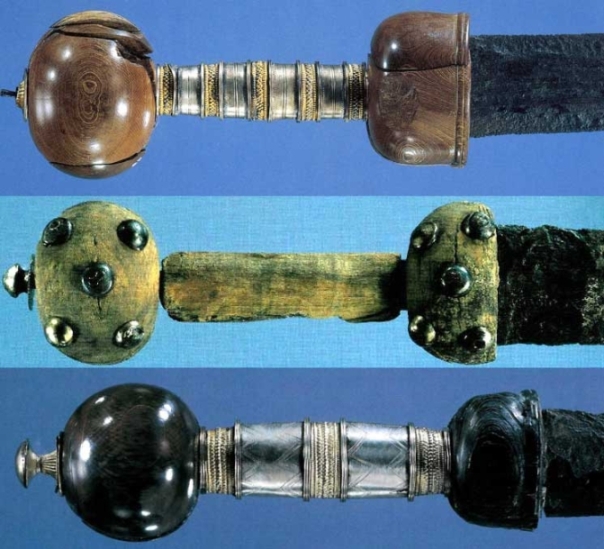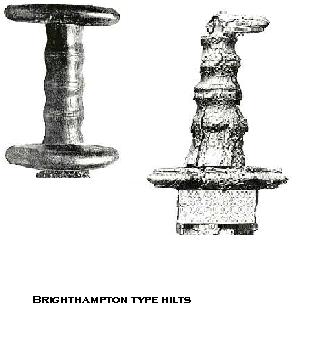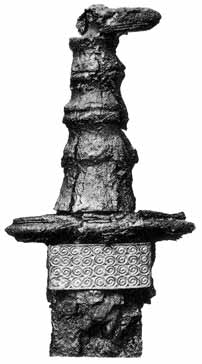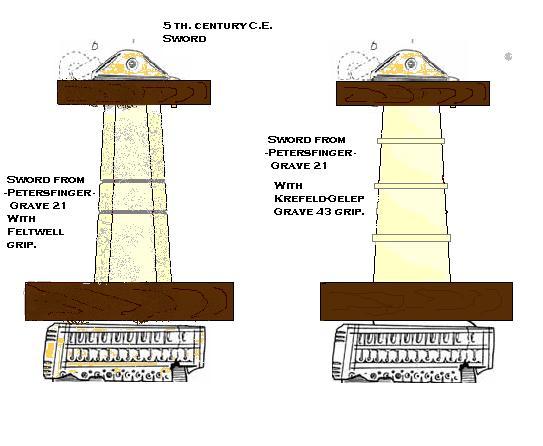Guys,
I'm wondering for quit a time now. I'm in the living history and re-enactment. Living the history of the Frisii 100 BC till 200 AD. Swords were very rare in our time so this is gonna be the first sword in the group. However, it is very hard to satisfie with the true Germanic sword... I have found some findings in the Netherlands... some spatha's that are dates 0-300 AD. However, the hilt is lost and if I;m going for the spatha, I need to come up with a Hilt that is historicially correct and nice too...
I have seen many Germanic swords, on this forum also... and I have searched for many bogs and founds of swords through Germanic Europe, however... I dont seem to get in that right time with the right information.
So... maybe you have some advise. Spatha's replica's our maybe some intresting finds and historic information about spatha hilts? I know for sure that I don't want the sword to be 'Roman'... maybe there are people with great ideas or good information and replica's.. :)
How about the Albion Cherusker? It isn't a spatha, but it's German and dates from the time period that you are aiming at.
http://www.albion-europe.com/swords/swords-by...?model=135
http://www.albion-europe.com/swords/swords-by...?model=135
I must admit that I'm unaware of anyone making a replica on a production basis but one of those Germanic "Banana shaped" seax (plural?) might be just the ticket and I believe they fall into the time period you're depicting.. I imagine making one wouldn't be impossible depending on how much authenticity you feel you want or need or are capable of producing.
I've always thought they were interesting weapons.
So would many seax in a room be...............seaxual congress?
Hmmmm.....I don't think that is the WORST pun I've ever made but it is probably one of the worst!
I've always thought they were interesting weapons.
So would many seax in a room be...............seaxual congress?
Hmmmm.....I don't think that is the WORST pun I've ever made but it is probably one of the worst!
I have looked at other weapons like the Albion Cherusker, Seax and Kampfmesser... However I really love the double-edged swords... It's the fighting which make it so charming. I discouvered the charme oif the double-edged sword wile I got some practice from Vikings.
The seax does not fit at our time period... The kampfmesser is pretty much alike and maybe also for the feuture a good thing to get.
But for now I am really intrested what I can make with the spatha... There are a few found in the Netherlands here. Without a hilt, only the blade. But I don't want it to be Roman... I am really curious if I can find that specific type of hilt which make it really 'Germanic'.
Some spatha's found in Holland:
http://www.rmo.nl/collectie/zoeken?object=k+1969%2f9.1
http://www.rmo.nl/collectie/zoeken?object=l+1971%2f11.8
http://www.rmo.nl/collectie/zoeken?object=VF*+1055
These actually does still have a grip :
http://www.rmo.nl/collectie/zoeken?object=k++1960%2f10.1
http://www.rmo.nl/collectie/zoeken?object=VF+536
The seax does not fit at our time period... The kampfmesser is pretty much alike and maybe also for the feuture a good thing to get.
But for now I am really intrested what I can make with the spatha... There are a few found in the Netherlands here. Without a hilt, only the blade. But I don't want it to be Roman... I am really curious if I can find that specific type of hilt which make it really 'Germanic'.
Some spatha's found in Holland:
http://www.rmo.nl/collectie/zoeken?object=k+1969%2f9.1
http://www.rmo.nl/collectie/zoeken?object=l+1971%2f11.8
http://www.rmo.nl/collectie/zoeken?object=VF*+1055
These actually does still have a grip :
http://www.rmo.nl/collectie/zoeken?object=k++1960%2f10.1
http://www.rmo.nl/collectie/zoeken?object=VF+536
Hey Magin!
What timeframe of 50 years are you aiming at., precisely?
The Messer-style single edged shortswords (I wouldn't use the term seax on them because of the entirely different hilt construction) are maybe even out of the timeframe. But you wanted a spatha, so what.
You write that your group portrays the Frisii from 100BC to 200 AD.
During the first hundred years of this timeframe, celtic longswords have been popular alongside with aforesaid single edged knives (which afaik derive from celtic ringhilt knives), the next 150 years some forms of gladius would have been used and finally the first forms of spathae, maybe type Canterbury-Kopki and Buch-Podlodow after M. Biborski.
Also the whole deal about swords during the roman iron age is a bit different from what you seem to imagine. Most of the blades in the Germania libera were imported from roman regions. The hiltstyles were essentially also identical. I have attached a picture of swordhilts from Illerup Ådal, dating around 200 AD. As you see, the general style of construction is roman, but some details of decoration are germanic. And these are not the majority of swords, most would remain with their original roman hilt. Only the swords the absolute elite would have been rehilted according to germanic tastes. A good reading here are the Publications of Jørgen Ilkjær on Illerup Ådal.
But what your group seems to portray is a germanic Tribe under roman governance, so there would even be less difference between roman weapons and frisian weapons.
By the way, there have been a series discussions related to germanic swords around here lately:
Most relevant for your topic, the development of different hiltstyles around 200 AD:
http://www.myArmoury.com/talk/viewtopic.php?t=21173
about visigoth swords in the 5th century :
http://www.myArmoury.com/talk/viewtopic.php?t...mp;start=0
(and some more, mainly coneconcentrating on migration period swords. )
And here is a link to a danish side about the hjortspring offering, showing some swords from 350 BC
http://www.hjortspring.dk/wold/dk/dk_swords.htm
But all efforts are futile without a more precise timeframe.
 Attachment: 225.5 KB
Attachment: 225.5 KB

three 3rd century spathae from Illerup
What timeframe of 50 years are you aiming at., precisely?
The Messer-style single edged shortswords (I wouldn't use the term seax on them because of the entirely different hilt construction) are maybe even out of the timeframe. But you wanted a spatha, so what.
You write that your group portrays the Frisii from 100BC to 200 AD.
During the first hundred years of this timeframe, celtic longswords have been popular alongside with aforesaid single edged knives (which afaik derive from celtic ringhilt knives), the next 150 years some forms of gladius would have been used and finally the first forms of spathae, maybe type Canterbury-Kopki and Buch-Podlodow after M. Biborski.
Also the whole deal about swords during the roman iron age is a bit different from what you seem to imagine. Most of the blades in the Germania libera were imported from roman regions. The hiltstyles were essentially also identical. I have attached a picture of swordhilts from Illerup Ådal, dating around 200 AD. As you see, the general style of construction is roman, but some details of decoration are germanic. And these are not the majority of swords, most would remain with their original roman hilt. Only the swords the absolute elite would have been rehilted according to germanic tastes. A good reading here are the Publications of Jørgen Ilkjær on Illerup Ådal.
But what your group seems to portray is a germanic Tribe under roman governance, so there would even be less difference between roman weapons and frisian weapons.
By the way, there have been a series discussions related to germanic swords around here lately:
Most relevant for your topic, the development of different hiltstyles around 200 AD:
http://www.myArmoury.com/talk/viewtopic.php?t=21173
about visigoth swords in the 5th century :
http://www.myArmoury.com/talk/viewtopic.php?t...mp;start=0
(and some more, mainly coneconcentrating on migration period swords. )
And here is a link to a danish side about the hjortspring offering, showing some swords from 350 BC
http://www.hjortspring.dk/wold/dk/dk_swords.htm
But all efforts are futile without a more precise timeframe.

three 3rd century spathae from Illerup
The swords with hilts on them are very nice, I didn't know them until now.
I don't really understand this one:
http://www.rmo.nl/collectie/zoeken?object=VF+536
Is there a closeup of the hilt? Anyway, it would have had the roman style semiglobular lower guard and globular pommel configuration.
The other one is a normal roman style lobed grip. There would have been disk shaped guards below and above it.
I don't really understand this one:
http://www.rmo.nl/collectie/zoeken?object=VF+536
Is there a closeup of the hilt? Anyway, it would have had the roman style semiglobular lower guard and globular pommel configuration.
The other one is a normal roman style lobed grip. There would have been disk shaped guards below and above it.
Hi Magin, I cant really add much to what Till J. Lodemann said above, but my suggestion would be, if you want to cover the 2nd century AD, but do not want to go with a conventional Roman style hilt, then go with a Behmer type 1 hilt. If on the other hand you would like to cover from the 1st century BC to the 1st century AD then I would go with either a germanic single sword or a La Téne III longsword.
Great information guys, I'm make progress for myself now!
However, there are new questions.
Lodeman, our timeframe is 100 BC till 200 AD... Most the time the 1st C. AD is most important for us because that's the time that out freedom comes with a price and we become in war with the Romans... battles and changes but with freedom as the price.
The messer-style swords (kampfmesser?), are very commen in Germanic Europe, so I have read too in some books. But there seems to be actually no evidence from archeology that they are found in the Netherlands... However, I don't know what findings are done in westen-Germany... That would also covere our tribe. Maybe somebody has some archeologic info about the single-edges swords/kampfmesser from western germany?
Than there is indeed a consideration if I shall choose for a La-Tene sword our a spatha. I mainly based this choise at the archeology in the Netherlands. I dont know if really is authentic for our tribe. I noticed that they are only found in the south of the Netherlands near Belgium. Could it be that the border of the la-Tene swords en culture stopped before reaching our land?
Although, it is a very good option to concider... I am open for some very nice and very late La-Tene swords from north-Germany?
Look, some La-Tene swords found in the south of the Netherlands:
http://www.rmo.nl/collectie/zoeken?object=e+1955%2f1.1
http://www.rmo.nl/collectie/zoeken?object=k+1969%2f5.1
http://www.rmo.nl/collectie/zoeken?object=NS+105a
http://www.rmo.nl/collectie/zoeken?object=k+1971%2f11.15
http://www.rmo.nl/collectie/zoeken?object=f+1966%2f11.1a
http://www.rmo.nl/collectie/zoeken?object=k+1973%2f4.1
Are there some examples of the Roman hilts you describe with the founds you have looked at? There is no close-up availeble of that one spatha you asked for.
And to Stephan, do you have a example of that Behmer type 1 hilt?
However, there are new questions.
Lodeman, our timeframe is 100 BC till 200 AD... Most the time the 1st C. AD is most important for us because that's the time that out freedom comes with a price and we become in war with the Romans... battles and changes but with freedom as the price.
The messer-style swords (kampfmesser?), are very commen in Germanic Europe, so I have read too in some books. But there seems to be actually no evidence from archeology that they are found in the Netherlands... However, I don't know what findings are done in westen-Germany... That would also covere our tribe. Maybe somebody has some archeologic info about the single-edges swords/kampfmesser from western germany?
Than there is indeed a consideration if I shall choose for a La-Tene sword our a spatha. I mainly based this choise at the archeology in the Netherlands. I dont know if really is authentic for our tribe. I noticed that they are only found in the south of the Netherlands near Belgium. Could it be that the border of the la-Tene swords en culture stopped before reaching our land?
Although, it is a very good option to concider... I am open for some very nice and very late La-Tene swords from north-Germany?
Look, some La-Tene swords found in the south of the Netherlands:
http://www.rmo.nl/collectie/zoeken?object=e+1955%2f1.1
http://www.rmo.nl/collectie/zoeken?object=k+1969%2f5.1
http://www.rmo.nl/collectie/zoeken?object=NS+105a
http://www.rmo.nl/collectie/zoeken?object=k+1971%2f11.15
http://www.rmo.nl/collectie/zoeken?object=f+1966%2f11.1a
http://www.rmo.nl/collectie/zoeken?object=k+1973%2f4.1
Are there some examples of the Roman hilts you describe with the founds you have looked at? There is no close-up availeble of that one spatha you asked for.
And to Stephan, do you have a example of that Behmer type 1 hilt?
For a Behmer type I hilt you could look at this thread http://www.myArmoury.com/talk/viewtopic.php?t=20991 about half way down the first page, posted by Till. J Lodemann, is a hilt made of horn, found at Nydam bog. If you look again at the first of the swords you posted that has a hilt, you will notice that, the tang does not seen long enough for the globilar style pommel of a Roman spatha. It is therefore possible that it had an upper and lower guard like the sword from Nydam. According to Oakeshott this hilt type was in use as early as about 150 AD, so it would cover the last part of your period. If you need something before this I believe you have a choice of a La Tene longsword or a Roman spatha.
Stephan, great! What you have noticed about one spatha, that is seems to have no room for typical roman pommel. I niticed that too, and that is wat also makes me curious.
Very nice information, I love the hilt by the way that you showed me. But is it not passing our timeline?
I'm also very much intrested about other spatha information and replica's of the 1st C. and from La-tene swords.. Wondering what it will do with my final choise
Very nice information, I love the hilt by the way that you showed me. But is it not passing our timeline?
I'm also very much intrested about other spatha information and replica's of the 1st C. and from La-tene swords.. Wondering what it will do with my final choise
This one is in deed a bit out of your timeframe. It can be dated to phase D1 of the roman iron age, rougly 375-440.
If Oakeshott dates this style to the latter half of the second century already, he is either unspecifical with his type (he just means organical H-shaped hilts with it) or plain wrong. :\
In the first 150 years AD, the romans did not use spathae that much. They had a long slender version of the pompeii style gladius for their cavalry (some call it a spatha) and otherwise only used gladii.
If your timeframe is 0-150, I would definetly go with a late La Tene style sword.
The romans used some celtic swords for their horsemen until the middle of the first century AD.
I have lately worked on the celtic/roman gravefield from Wederath/Belginum and can scan and post some swords of the LT D 2b - Roman ironage B1 timeframe later today if you want (and nobody is faster :D )
If Oakeshott dates this style to the latter half of the second century already, he is either unspecifical with his type (he just means organical H-shaped hilts with it) or plain wrong. :\
In the first 150 years AD, the romans did not use spathae that much. They had a long slender version of the pompeii style gladius for their cavalry (some call it a spatha) and otherwise only used gladii.
If your timeframe is 0-150, I would definetly go with a late La Tene style sword.
The romans used some celtic swords for their horsemen until the middle of the first century AD.
I have lately worked on the celtic/roman gravefield from Wederath/Belginum and can scan and post some swords of the LT D 2b - Roman ironage B1 timeframe later today if you want (and nobody is faster :D )
Thank you for the correction Till. I have just taken another look at Oakeshott's AOW and realised that I was miss-remembering. I should have said Behmer type II (which are similar to type I but with a bronze or silver plated hilt). Examples of this type have been found in Thorsbjerg bog, which (again according to Oakeshott) dates to between 60 and 200 AD.
what about the feltwell sword, a little known one found with most of its hilt under a roman floor in suffolk (my home)
 Attachment: 15.96 KB
Attachment: 15.96 KB

 Attachment: 9.87 KB
Attachment: 9.87 KB

not sure if this is the same
 Attachment: 34.79 KB
Attachment: 34.79 KB

 Attachment: 28.31 KB
Attachment: 28.31 KB

replica(ish)


not sure if this is the same


replica(ish)
| K J Seago wrote: |
| what about the feltwell sword, a little known one found with most of its hilt under a roman floor in suffolk (my home) |
Thnx for the good info... Lodeman, you say that I have to consider the La-Tene swords... I am very cusrious, what examples do you have of the late La-Tene swords.. By this time I am very much intereseted in the latest La-Tene swords.
So everybody with late La-Tene Hilt types, replica's and information from western-Germany, Belgium and the Netherlands... feel free to post!
I think the Feltwell sword is indeed out of my time period.. however it really is a beauty! But not very authentic for my group I think..
And that Behmer II type abnd the Thorsbjerg bof finds.. and foto's and info about that?
Somehow I stay in that fascination of the spatha... I'm just wondering and wondering about the fact that there are several spatha's found in the Netherlands... (La-Tene swords even more though). But I finds it very weard that there have been found no single-edged swords in the Netherlamnd... according to the info I have now. Maybe I am incomplete. I'll bee diging in some books these days!
For now I cabn't wait at the La-Tene info and Hilts... and some more spatha info! There is some good knockledge present at this forum!
So everybody with late La-Tene Hilt types, replica's and information from western-Germany, Belgium and the Netherlands... feel free to post!
I think the Feltwell sword is indeed out of my time period.. however it really is a beauty! But not very authentic for my group I think..
And that Behmer II type abnd the Thorsbjerg bof finds.. and foto's and info about that?
Somehow I stay in that fascination of the spatha... I'm just wondering and wondering about the fact that there are several spatha's found in the Netherlands... (La-Tene swords even more though). But I finds it very weard that there have been found no single-edged swords in the Netherlamnd... according to the info I have now. Maybe I am incomplete. I'll bee diging in some books these days!
For now I cabn't wait at the La-Tene info and Hilts... and some more spatha info! There is some good knockledge present at this forum!
| Magin Hard wrote: |
| And that Behmer II type abnd the Thorsbjerg bof finds.. and foto's and info about that? |
If you look at the last post on this thread http://www.myArmoury.com/talk/viewtopic.php?t=21173 you will find the hilt I was refering to. You could also try using the sites search function and look for Behmer, as there have been many discussions about his typology lately. Happy hunting :-)
Thnx Stephan, I love these hilts you shared with me. However I am afraid it is passed our time (100 BC - 200 AD). Unless you or somebody else has some nice info about these hilts that the can be authentic for my time?
Therefore I am also curious for some late La-Tene style hilts..
Therefore I am also curious for some late La-Tene style hilts..
Are there any people with replica's of early spatha's? Maybe some hilt designs?
Hey Magin! Sorry that it took me so long to reply, my computer had some serious problems and I had to reinstall windows :\
Anyway, I have looked into my files and found that most of the swords we got there will not be that usefull for you, they have mostly organic hilts and are bent and rusted.
In this discussion are plentifull information and pictures about celtic swords:
http://www.myArmoury.com/talk/viewtopic.php?t...ene+swords
in the last post of the first page you will even find the hilt of a sword from Wederath/Belginum. A very interesting one, by the way, not only one of the very few with composite construction but also as the blade of the sword was found in another grave then the hilt!
A commonly known and good smith in europe is Patrick Barta, he also made some nice, slightly earlier latene swords. You can see them on his webpage:
http://www.myArmoury.com/talk/viewtopic.php?t...ene+swords
PS: Lodemann is my family name; you can call me Till :cool:
Anyway, I have looked into my files and found that most of the swords we got there will not be that usefull for you, they have mostly organic hilts and are bent and rusted.
In this discussion are plentifull information and pictures about celtic swords:
http://www.myArmoury.com/talk/viewtopic.php?t...ene+swords
in the last post of the first page you will even find the hilt of a sword from Wederath/Belginum. A very interesting one, by the way, not only one of the very few with composite construction but also as the blade of the sword was found in another grave then the hilt!
A commonly known and good smith in europe is Patrick Barta, he also made some nice, slightly earlier latene swords. You can see them on his webpage:
http://www.myArmoury.com/talk/viewtopic.php?t...ene+swords
PS: Lodemann is my family name; you can call me Till :cool:
That Feltwood sword replica looks impressive especially its blade. Why does the hilt look like unfinished?
Page 1 of 1
You cannot post new topics in this forumYou cannot reply to topics in this forum
You cannot edit your posts in this forum
You cannot delete your posts in this forum
You cannot vote in polls in this forum
You cannot attach files in this forum
You can download files in this forum
All contents © Copyright 2003-2006 myArmoury.com — All rights reserved
Discussion forums powered by phpBB © The phpBB Group
Switch to the Full-featured Version of the forum
Discussion forums powered by phpBB © The phpBB Group
Switch to the Full-featured Version of the forum